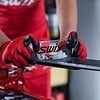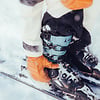Nordic | Crosscountry Pole Buying Guide
Nordic Pole Basics.
At Skihut we carry poles fromAtomic,KV+, OneWay,Salomon, andSwix.
They’re Poles. How Different Can They Be?
Way. Nordic (XC) ski poles are as varied as the skiers who use them. From deep-snow trail breaking to World Cup racing. XC ski poles come in a myriad of styles, each purpose built for a specific application. The best way to differentiate between them is to talk about parts. As the parts of the pole change - so does that pole’s job.
A Strong Core.
The shaft is the main body - or core - of any ski pole. Ski pole shafts are most commonly made from aluminum, fiberglass, or carbon fiber. Aluminum shaft poles are typically the least expensive. Aluminum poles are either straight-gauge (the same diameter from end-to-end) or tapered (progressively slimmer toward the lower end). Straight-gauge aluminum poles are heavy and flimsy compared to their tapered cousins. They are also inexpensive - as low as $15 - $25 per pair. They get the job done and they don’t break easily. Tapered aluminum poles feel much lighter (swing weight) and sometimes come with racing or back-country specific components. Tapered aluminum poles can cost $35 - $100 or more per pair. Fiberglass shafts are becoming increasingly rare. But they can be a very good buy as, while they may be a bit heavy, they can be very durable. Fiberglass is sometimes combined with carbon fiber for less expensive race pole shafts. Carbon fiber is used for the most expensive pole shafts. Depending on the percentage of carbon or what (or how much) resin is used in manufacturing - carbon fiber poles can range from $50 - $700. Oddly the most expensive carbon poles are also the least durable. They are incredibly stiff and light, making them amazingly efficient. But good ski technique is a must. These poles are easily broken if leveraged incorrectly.
The Touch Points.
The touch points on an XC ski pole are the grip and the strap. The grip is typically made of plastic, cork, or a blend of both. Plastic grips are usually found on less expensive poles. Plastic retains cold and adds weight. Cork grips do not feel as cold as plastic grips and they are considerably lighter than plastic grips.
The strap can be a simple, straight loop or a complex integration of velcro, zippers, and snaps. Contrary to some beliefs, the strap is not there to keep you from losing your pole in the snow. It is actually there to help you ski more efficiently! When used properly the strap helps to propel you forward while allowing your hand to relax. A relaxed hand is a warmer, and less tired, hand. The more complex a strap looks - likely the more efficiently it skis. Simple straps are usually on less expensive poles while more complex straps are usually on more expensive poles. Some straps even click in and out of the handles! Let’s say you need to grab your phone, or a snack, from your jacket pocket. Instead of having to un-velcro your hand and pull it out of the strap, you simply tap a release button, and the strap pops out of the handle! So much quicker and easier.
Where The Rubber Meets The Road.
The part of the ski pole that touches the snow consists of two parts, the tip (ferrule) and the basket. The tip’s job is to bite into the trail so you can push forward. The basket’s job is to keep the tip from sinking too far into the trail. On many poles these two parts are actually one - molded together in manufacturing. On other poles they are two distinct and separate parts. Some race poles have quick-switch basket options so that the skier can easily switch from a small basket (for hard tracks) to a bigger basket (for softer tracks).
The tip is usually metal, though some children’s poles may have blunt plastic tips for obvious safety reasons. Metal tips can either be steel, hardened steel, or carbide. Regular steel tips are rather dull and can be found on less expensive poles. Hardened steel tips are very sharp and will be found on mid-level race poles or high end tour poles. Carbide tips will be found on more expensive race poles as they are light, extremely hard and durable, and very sharp.
Baskets mainly differ by size. The bigger the basket the more it will keep the tip from “post-holing” or sinking into the snow. A big, round basket is usually used on poles designed to be used in deep snow while tiny baskets are for racing on extremely firm tracks. Of course there are many, many sizes and shapes in between.
What To Know.
Choosing the correct pole is very important. A race pole is a terrible choice for backcountry skiing just as a backcountry pole is a terrible choice for racing. Go to your local shop and explain where and how you are skiing. They will set you up right. Please know that most parts are replaceable and that many parts are interchangeable (but not all). Any good shop will have part options available for upgrades or replacements.


 Shop
Shop
 Service & Repair
Service & Repair
 38th Annual Ski Hut Bozeman Trip
38th Annual Ski Hut Bozeman Trip
 Wax Clinics
Wax Clinics
 Ski Hut Blog
Ski Hut Blog
